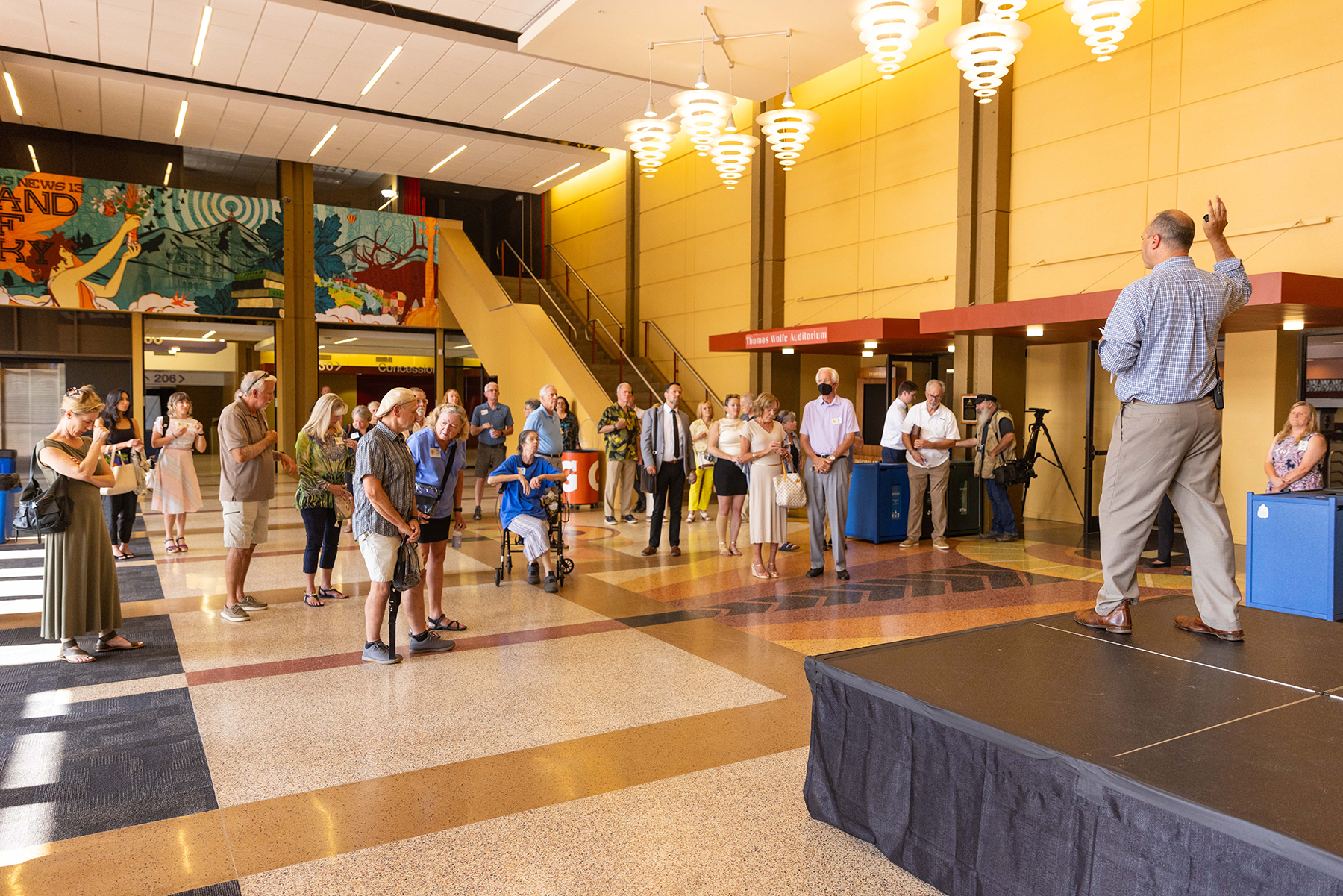
Behind the Scenes Tour of Thomas Wolfe Auditorium during the ArtsAVL Town Hall on Aug 21
Thomas Wolfe Auditorium FAQs
This page will continue to be updated as the discussion evolves.
Why support renovating Thomas Wolfe?
The Thomas Wolfe Auditorium (TWA) is a site of architectural and cultural importance within the downtown business district. It is also part of a larger City-owned civic entertainment complex that includes a large parking garage, meeting rooms, and arena. Building a new facility of similar size and scope is estimated to cost equal to or more than a similar scoped renovation and will also have costs associated with land acquisition and development. Additionally, the City would still have some required investment in the TWA in order to keep the doors open long term. No site is currently identified for a new build.
This location has served as the indoor public gathering space within Western North Carolina for community engagement, sporting events, graduations, concerts, and more for over 100 years.
Why can’t hotels be a funding source for the auditorium?
Are public-private funding arrangements being explored? Are there plans to explore alternative funding sources or partnerships to support the auditorium’s revitalization and long-term sustainability?
How does the proposed “quick-fix” solution ensure the safety of attendees during reduced-capacity, non-ticketed events considering the ongoing situation?
What are the key factors that will be taken into account when evaluating the success of the “quick-fix” solution and its impact on the community?
For example, if the City were to allow a small 600 person dance event to book the Arena Theater for a weekend in March, that weekend would no longer be available for larger touring concerts, which bring a significantly larger economic impact to the community.
Given the concerns about the impact of the closure on the local community, what steps are being taken to mitigate the long-term effects of the auditorium’s closure?
How does the proposed plan align with the city’s broader cultural and economic development goals for the downtown area?
Council’s VIsion 2036 has eight central tenets: An equitable and diverse Community; A well-planned and livable community; A clean and healthy environment; quality affordable housing, transportation and accessibility; A thriving local economy; A connected and engaged community; and A financially resilient city. Renovation plans for the Thomas Wolfe Auditorium will connect directly to several of these pillars.
What considerations have been given to make the auditorium accessible and inclusive to a diverse range of performers and audiences?
Can you provide more information about the potential benefits and drawbacks of fully closing the auditorium, as mentioned in the statement?
The entire complex, which includes the ExploreAsheville.com Arena, Thomas Wolfe Auditorium, nine meeting spaces, and a banquet room, results in almost $79.6 million in economic impact per year. Approximately $30 million is from the Thomas Wolfe Auditorium. City staff currently estimate that about half of the equivalent programming will be lost compared to the prior fiscal year, and within that half the larger performances of concerts and special events. Therefore, the partial closure, with the facility reopening in the fall of 2023 to limited capacities will result in an approximate reduction of economic impact to Buncombe County of $20.5 million.
How will feedback and input from the ArtsAVL Town Hall be incorporated into the decision-making process moving forward?
How much money and manpower is allocated to the maintenance of this facility? What's the inspection schedule?
What happened to funds from the previous efforts in 2020?
Is the City contractually obligated to the Symphony to provide a suitable venue?
Could the “Pit of Despair” be sold to raise funds for Thomas Wolfe, or otherwise activated in some way that would support the renovation?
In October of 2020, The Haywood Page Conceptual Master Plan was unanimously approved by City Council. The Plan is for City-owned properties on Haywood St. and Page Ave. in downtown Asheville. This Plan would activate the Haywood Page area, and the conceptual design includes native gardens and park space, a central plaza, public art, market stalls, and a mixed-used development that could include retail/work/live space. There may be an opportunity to link this site in the short or long term. If the Haywood-Page area is redeveloped, the City may consider any economies of scale that could improve Thomas Wolfe, including building and back of house access.
Council has not yet directed staff to implement the Plan. There are no current plans to sell the site.
How many non-ticketed events happen in the Auditorium? What are they?
What are the next steps in this decision-making process? Who are the decision makers?
How was/is the Peace Center in Greenville funded? Is a similar path possible for Thomas Wolfe?
The Peace Center was founded by a group of individuals dedicated to fundraising for a performing arts space, and had an initial $10M pledge of support from the Peace Family. A subsequent $42M was raised after this initial pledge. In 2012, the Peace Center concluded a renovation funded by a $21.5M capital campaign.
A similar path is certainly possible for the TWA; however, a group of individuals in Asheville have been unsuccessfully advocating and fundraising for a performance center for nearly 20 years with the intent of a similar funding model to the Peace Center. It is unlikely that a single donor or family in the area will contribute an initial pledge as sizable as the Peace family’s.
Will renovations allow for the preservation of the auditorium’s historic elements?
How does the Duke substation affect the renovation plans?
In the nine designs created so far for a Thomas Wolfe renovation, the substation moving was not considered. Duke has been a supportive partner and has asked the City what would be needed if they did rebuild the substation. As Chris Corl noted in the Town Hall, “Moving out is cheaper than moving up.”
